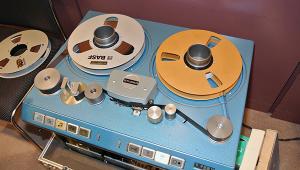Opinion: Let the past be the past

Your envisioned system is theoretically capable of 20Hz-20kHz, but the upper octave is buried in noise and the bottom one exceeds the limits of your physical carrier. Your practical frequency response shrinks to 40Hz-10kHz, still adequate for most purposes. Associated specifications include best-case 65dB signal-to-noise ratio, 30dB channel separation and pitch accuracy (on a good day) of ±2%, still OK for practical purposes but far from high fidelity as it’s commonly defined today. Question: How quickly would you be laughed out of engineering school?
Glowing bottles
Let’s imagine further that you’ve decided that the current trend toward compact, high-efficiency amplifiers is completely misguided – that instead, our predecessors were on the right track with valve amplification. You’re soon awash in heavyweight room heaters with glowing bottles, massive transformers and power supplies with potentially lethal voltages. Where does all this lead? See the previous question.
This little rant had a couple of triggering events. Some background: I once had an LP library that wrapped around three sides of a good-size room. Aside from collectible curios, such as an RCA Victor RP-190 record changer, my main disc spinner was a VPI HW-19 with a Well-Tempered arm and Van den Hul cartridge, a combo I dearly loved. When we sold the house, the bulk of the LPs went into storage. I had one crate of desert-island favourites but most of my listening had migrated to CD.
Then came the decision to move cross-country. I had learned to live without my LPs, and in prepping to move, I held a week-long sale during which the vinyl found new homes among the record-collecting fanatics of Atlanta. I sold the VPI turntable to a good friend whose capacious walk-in closet was his LP library.
I went 25 years without a record player. Then last summer I picked up a used HW-19 with a Sumiko Blue Point cartridge and was back playing desert-island favourites – but without my prior enthusiasm. The joy was gone. One day I cued up the soundtrack from Letter To Brezhnev, a film I had loved both for the story and the music. The album was too warped for the VPI’s clamp to offer any benefit. I watched the arm bob up and down like some miscreant amusement park ride, with one thought: why am I doing this?
Two days later another friend took the VPI. The next day I was knocked momentarily unconscious by a 500V discharge from a misbehaving antique valve amp – partly my fault for being incautious, and partly the fault of the thing’s designer, unaware of what can happen when unlike metals share electrical currents.
Brutally stupid
I flew into a rage, smashed the amp to bits, and heaved it into the trash – an immensely satisfying display of infantile aggression. I hate antique gear. There is something incomprehensibly, brutally stupid about needing hundreds of volts to swing a modest output signal. Tubes may have made sense in 1935 or 1959 – insert your Golden Age here, when people didn’t know any better – but they don’t make a lick of sense today. Not to me.
If you simply must have an abundance of sweet second harmonics, any number of studio devices can deliver them for you – without the cost, the inconvenience, the heat, or the danger. My wish for the approaching New Year? Let the past be the past. Please.





















































